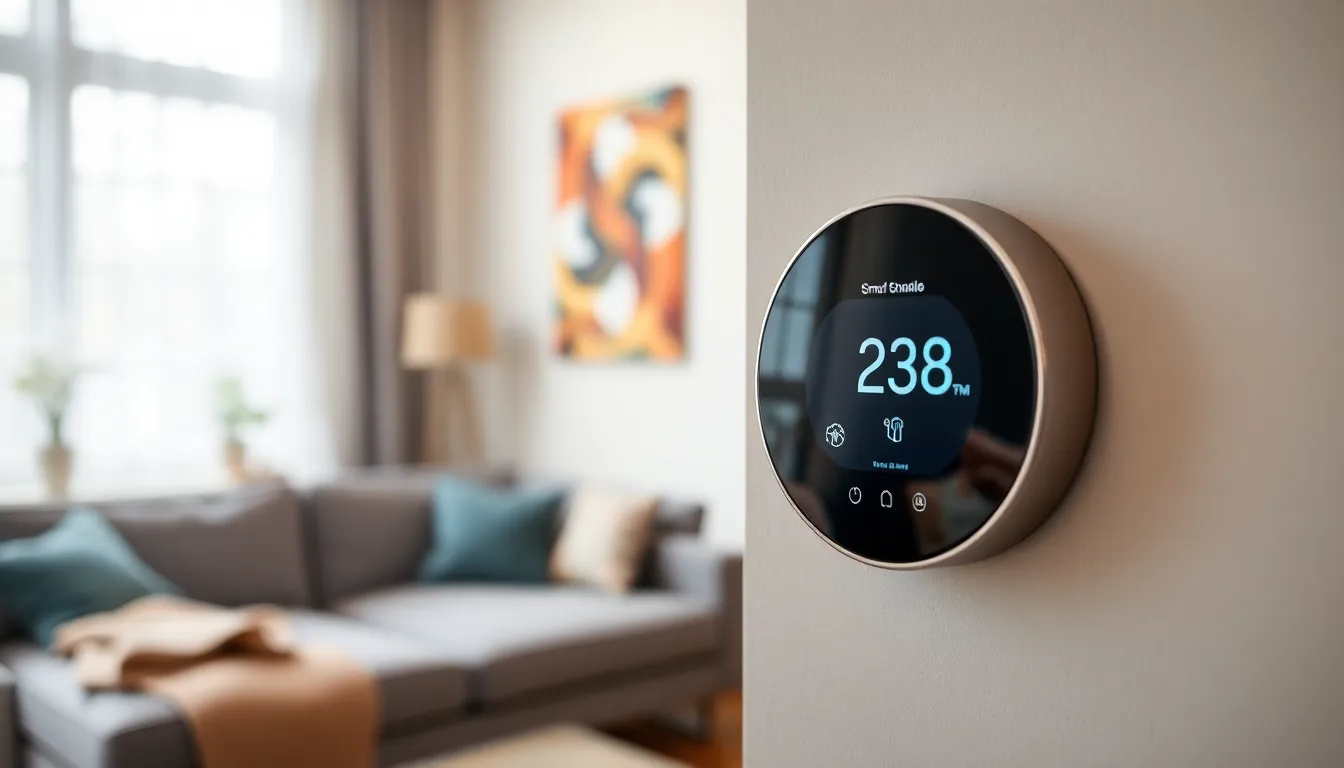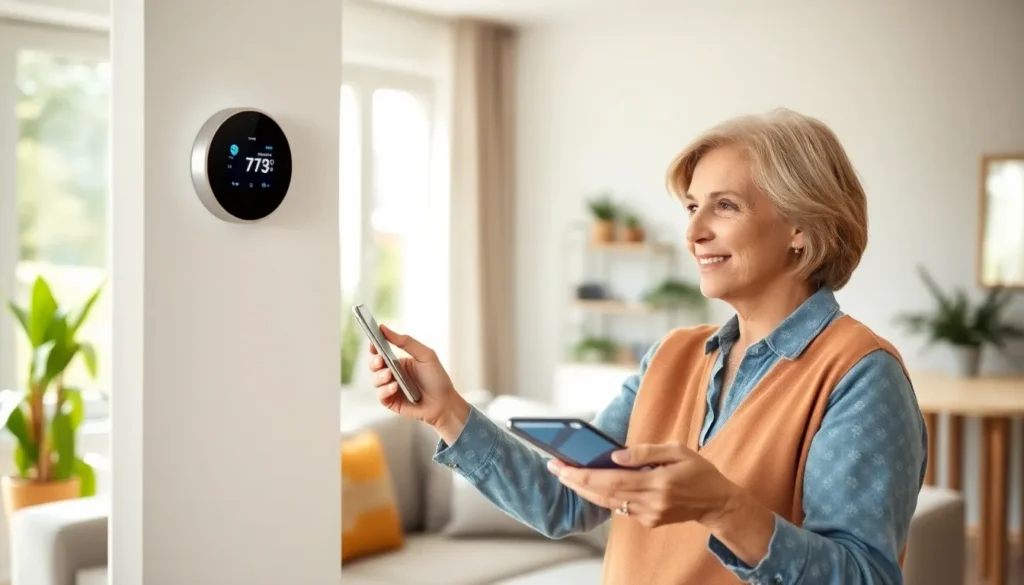In a world where everything seems to be getting smarter, why should your thermostat be left out? Smart thermostats are the unsung heroes of home energy efficiency, quietly working behind the scenes to keep your home cozy while saving you a few bucks. Imagine a device that learns your schedule, adjusts temperatures based on your habits, and even lets you control it from your phone while lounging on the couch. Sounds like magic, right?
Table of Contents
ToggleOverview Of Smart Thermostats
Smart thermostats represent a significant advancement in home climate control technology. These devices learn user preferences and adjust heating and cooling schedules automatically to optimize energy usage. By analyzing patterns, smart thermostats can create comfortable environments while conserving energy, leading to lower utility bills.
Integration with smartphones allows remote temperature management. Users can easily monitor and control their home’s climate from anywhere. Many smart thermostats feature geofencing capabilities, adjusting temperatures when occupants leave or return home. This feature enhances comfort and further contributes to energy savings.
Some models provide detailed energy usage reports. This data helps users identify usage trends and make informed decisions about their heating and cooling habits. Smart thermostats often integrate with other smart home devices, including lights and security systems, offering a seamless home automation experience.
Compatibility with voice assistants like Amazon Alexa and Google Assistant adds convenience. Users can adjust their home temperatures with simple voice commands, making climate control accessible to everyone. Advanced features, such as learning algorithms, enable these devices to adapt to changing habits over time.
Investing in a smart thermostat brings tangible benefits to homeowners. Energy savings, enhanced comfort, and improved convenience create a compelling case for upgrading traditional thermostats. As energy efficiency becomes increasingly important, smart thermostats play a pivotal role in transforming how consumers manage their homes’ climates.
Key Features Of Smart Thermostats

Smart thermostats come equipped with various features that enhance energy management and user experience. Understanding these features helps users maximize their benefits.
Energy Efficiency
Energy efficiency stands out as a primary benefit of smart thermostats. These devices adjust heating and cooling based on user behaviors, which can lead to energy savings of up to 10-15%. They analyze data from user habits and patterns to optimize energy usage, significantly lowering utility bills. Models with geofencing automatically adjust settings when users leave or return home, ensuring comfort without excess energy use. Detailed energy reports available on many smart thermostats empower users to make informed decisions and modify their consumption habits.
User-Friendly Interface
User-friendly interfaces characterize most smart thermostats, making them accessible for everyone. Touchscreens display clear information, facilitating easy navigation and adjustments. Many devices offer mobile apps that complement the thermostat, allowing users to manage settings seamlessly. Color coding and intuitive menus help clarify options, reducing any confusion. Simple installation processes mean that even those with minimal tech experience can set them up without professional assistance.
Remote Access
Remote access capabilities enhance the convenience of smart thermostats significantly. Users can control their home’s temperature from anywhere using smartphones. The ability to make instant adjustments ensures comfort after long days or during unpredictable weather changes. Notifications alert users about significant temperature fluctuations, which can aid in preventing heating or cooling issues. Integration with home automation systems streamlines control over multiple devices, providing a comprehensive smart home experience.
Benefits Of Using Smart Thermostats
Smart thermostats offer numerous advantages that enhance both user experience and home energy efficiency.
Cost Savings
Annual savings range from 10% to 15% on energy bills due to smart thermostats’ ability to learn user patterns. Continuous analysis of usage habits leads to optimized heating and cooling schedules, reducing unnecessary energy consumption. Homeowners can adjust temperatures remotely, ensuring energy isn’t wasted when no one is home. Detailed energy reports provide insights, helping individuals make informed decisions about energy use. Lower utility bills contribute significantly to overall savings, making smart thermostats a wise investment for homeowners aiming to reduce expenses.
Environmental Impact
Reducing energy consumption plays a crucial role in lessening environmental footprints. Smart thermostats help achieve this by optimizing energy use based on daily habits. By adopting energy-efficient practices, users decrease the demand for fossil fuels needed to power heating and cooling systems. Enhanced monitoring capabilities allow for timely adjustments that match occupancy, reducing waste. Consequently, the cumulative effect contributes to lower greenhouse gas emissions, promoting sustainability and environmental responsibility. Smart thermostats not only save money but also foster a greener planet.
Popular Smart Thermostat Models
Smart thermostats come in various models, each offering unique features. Brands like Nest, Ecobee, and Honeywell lead the market, providing advanced options for every home.
Model Comparison
Nest Learning Thermostat learns user preferences over time and offers an intuitive interface. Ecobee SmartThermostat includes room sensors, enhancing comfort by adjusting temperatures based on occupancy. Honeywell Home T9 stands out with a focus on energy savings and customizable settings. All models support remote control through mobile apps, enabling adjustments on the go. When comparing energy-saving capabilities, Nest and Ecobee both claim potential savings of 10-15%. Each model integrates seamlessly with smartphones and smart home systems, making them practical choices for modern households.
Customer Reviews
Users praise Ecobee for its user-friendly setup and reliability, often citing the effectiveness of the room sensors. Nest impresses many with its elegant design and adaptive learning, making heating and cooling adjustments more efficient. Reviewers frequently highlight Honeywell’s affordability and solid performance in energy management. Positive feedback consistently mentions remote access, which allows for immediate temperature adjustments. Customers appreciate the detailed energy reports provided by these models, aiding them in understanding usage patterns. All three models have received high ratings for customer support, ensuring assistance is readily available when needed.
Installation And Setup
Installing a smart thermostat involves a few straightforward steps. Start by turning off the power to the heating and cooling system at the circuit breaker. Removing the existing thermostat requires careful handling of the wires; labeling each wire ensures correct placement later.
Next, mount the smart thermostat’s base to the wall, aligning it with the labeled wires. Secure the thermostat using the provided screws. The display connects to the base after connecting the wires, making it easy to complete the setup.
Many smart thermostats provide an intuitive setup process via their mobile apps. Downloading the corresponding app allows users to follow on-screen instructions for connecting the thermostat to the home’s Wi-Fi network. Once connected, users can often input their heating and cooling preferences, tailoring the device to their lifestyle.
Integration with voice assistants like Amazon Alexa or Google Assistant enhances usability. Users can control temperature settings with simple voice commands. Lastly, conducting a system test confirms the installation’s accuracy, ensuring optimal performance from the start.
Some models provide step-by-step guides and video tutorials accessible through the app, helping users anytime during installation. Assistance from customer support is also available for any queries that might arise. This straightforward installation and setup process effectively empowers users to take charge of their home climate control efficiently.
Smart thermostats are revolutionizing home energy management by combining convenience with efficiency. They adapt to user habits and preferences while offering remote access for temperature control. With potential savings on energy bills and a positive environmental impact, these devices are a smart choice for homeowners looking to enhance comfort and sustainability.
The variety of models available ensures that users can find one that fits their needs, whether it’s intuitive learning or advanced features like room sensors. As technology continues to evolve, smart thermostats will play an increasingly vital role in creating energy-efficient homes. Investing in one not only leads to immediate benefits but also contributes to a greener future.





